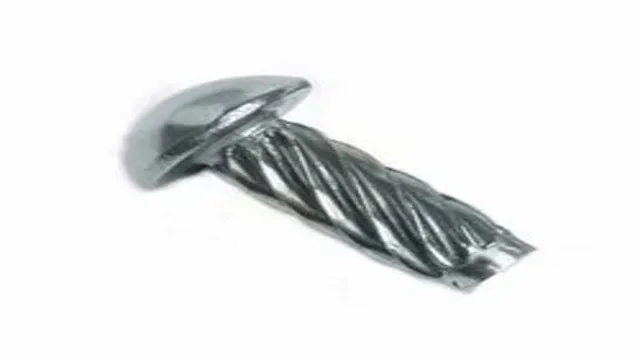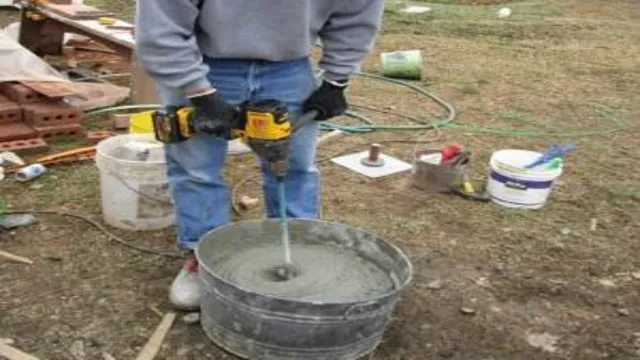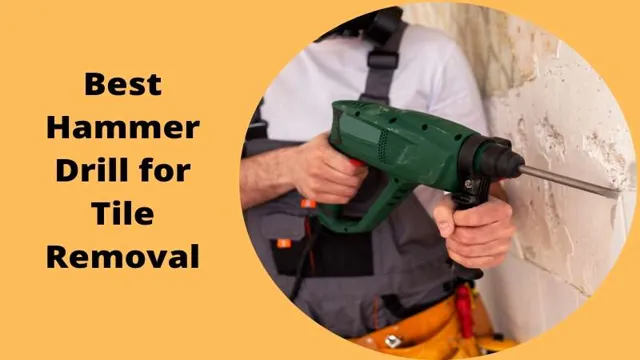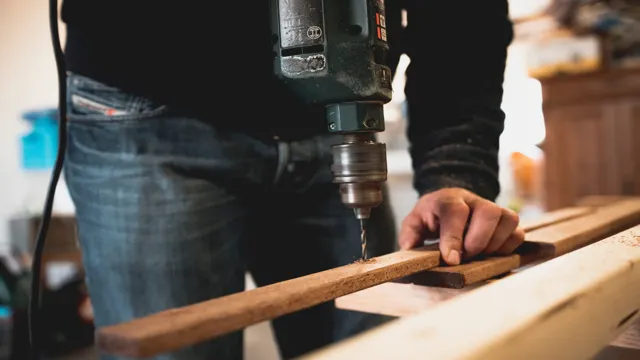Can I Use Impact Driver as Hammer Drill? Pros and Cons of Dual Use.
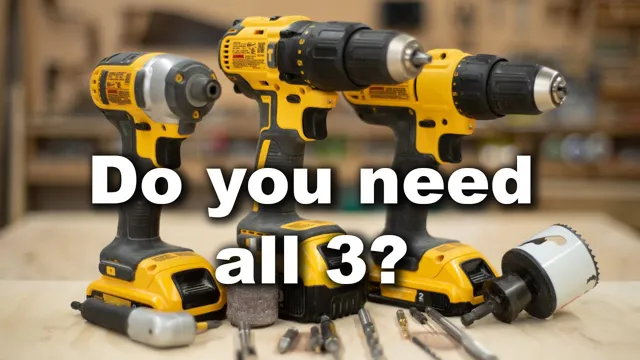
Are you tired of constantly switching between tools while working on projects that require drilling and impacting functionalities? Do you wish you could use a single tool that can fulfill both purposes? If your answer is yes, then you might be interested in using an impact driver as a hammer drill. Although not commonly known, an impact driver can be used as a hammer drill, saving you both time and money. Impact drivers are primarily used for driving screws and nuts with high torque and speed, but they can also be used for drilling tasks.
They are lightweight, compact, and easy to handle, making them a convenient choice for both professionals and DIYers alike. In this blog, we will discuss how you can transform your impact driver into a hammer drill and the various benefits of doing so. We will also cover the differences between a hammer drill and an impact driver, as well as their respective strengths and weaknesses.
By the end of this blog, you’ll have a deeper understanding of the capabilities of an impact driver and be able to use it effectively for a wider range of tasks. So, let’s get started and discover how you can elevate your DIY game with just one tool!
Understanding the Differences Between Impact Drivers and Hammer Drills
Can you use an impact driver as a hammer drill? While both tools share similarities in terms of their function, they are fundamentally different and designed for different purposes. Impact drivers are best used for driving screws and tightening bolts due to their fast rotational speed and high torque output. On the other hand, hammer drills are more suitable for drilling into hard materials like concrete, brick, and stone.
They are designed to apply a forceful forward thrust, known as hammering, which helps to break through tough materials. Attempting to use an impact driver to drill into hard materials can result in damage to the tool and a lack of success in the task at hand. It’s best to invest in a hammer drill if you need to work with hard materials and stick with an impact driver for driving screws.
Impact Driver vs. Hammer Drill
When it comes to heavy-duty drilling and driving tasks, you may wonder whether you should use an impact driver or a hammer drill. Both tools are designed for specific applications, and it’s crucial to understand their differences before choosing one. An impact driver is primarily used to drive screws and bolts into tough materials like concrete, metal, and masonry.
This tool delivers strong rotational force and torque to fasten screws with ease, thanks to its unique pounding mechanism. On the other hand, a hammer drill is designed to drill holes through hard surfaces, such as brick, stone, and concrete. This powerful tool uses a pounding motion to chisel and break through hard materials.
However, some hammer drills also come with a drilling-only mode, making them suitable for softer materials like wood and plastic. Ultimately, the choice between these two tools depends on the type of task you want to perform. If you need to drive screws into tough materials, an impact driver is the right tool for the job.
However, if you need to drill through hard surfaces, a hammer drill is the best choice.
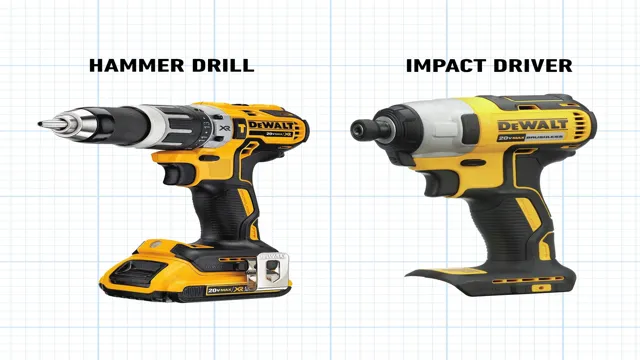
Purpose and Functionality
When it comes to drilling and fastening tasks, the debates between impact drivers and hammer drills continue. Both tools have their own unique purpose and functionality, and while they may seem similar at first glance, they operate differently. Impact drivers are best-suited for driving screws and tightening nuts and bolts with high torque, making them ideal for heavy-duty tasks on hard surfaces.
On the other hand, hammer drills are designed for drilling holes into tough materials like concrete, brick, and masonry by hammering the drill bit into the surface with a pulsating action. While both tools can be used interchangeably, it’s important to understand their differences to ensure you choose the right tool for the job.
Can You Use an Impact Driver as a Hammer Drill?
If you’re wondering whether or not you can use an impact driver as a hammer drill, the answer is no, you can’t. While these two tools may look similar in appearance, they are designed for different purposes. An impact driver is a power tool used for driving screws and tightening bolts, while a hammer drill is designed specifically for drilling holes into tough materials like concrete and masonry.
While an impact driver may be able to create small holes in softer materials like wood, it lacks the power and the hammering action needed to drill through harder materials. So if you need to drill into concrete or masonry, it’s important to use a hammer drill instead of an impact driver. However, if you only need to drive screws or tighten bolts, then an impact driver will work just fine.
So don’t make the mistake of using the wrong tool for the job. Always make sure you’re using the right tool for the task at hand.
Advantages of Using an Impact Driver as a Hammer Drill
“impact driver as a hammer drill” Yes, you can use an impact driver as a hammer drill, and there are advantages to doing so. One of the biggest benefits is the speed and power at which an impact driver operates. An impact driver is designed to deliver powerful rotational force and torque quickly and efficiently, making it ideal for drilling and driving screws into hard materials like concrete, stone, and metal.
The impact driver’s rapid rotational action also creates a sort of percussive force, which can help break up and loosen tough materials, making it an effective hammer drill substitute. Additionally, an impact driver is generally more compact and lightweight than traditional hammer drills, making it easier to maneuver and use in tight spaces. However, keep in mind that impact drivers are not specifically designed for hammer drilling and may not be as effective as a dedicated hammer drill in certain applications.
So, while you can certainly use an impact driver as a hammer drill, it’s always best to use the tool that is designed for the job at hand for optimal results.
Disadvantages of Using an Impact Driver as a Hammer Drill
Impact Driver as a Hammer Drill Using an impact driver as a hammer drill is a common query among DIY enthusiasts, and while it may seem like a cost-effective solution, it is not advisable. An impact driver is designed to provide a high-torque, rotational force for driving screws into different materials like wood and metal. On the other hand, a hammer drill uses a specialized mechanism called the “hammer and anvil system,” which provides a rapid and high impact force.
It functions by driving the drill bit into the surface and simultaneously rotating it, creating an effective hole. Although you may be tempted to use your impact driver as a hammer drill, an impact driver’s rotational torque is not enough to drill into hard materials like concrete walls, which can lead to damage to both the bit and the drill. Therefore, it is ideal to use the right tool for the right job to avoid disappointments and keep your equipment safe and functional.
Impact Driver Compatibility with Hammer Drill Bits
When it comes to drilling through tough materials like concrete, using a hammer drill is typically the go-to choice for most people. However, some may wonder if an impact driver can also be used as a hammer drill. The answer to that is both yes and no – while an impact driver may physically be able to use hammer drill bits, it’s not advised to do so as it can cause damage to the tool.
Impact drivers are designed to deliver high-torque rotational force for driving screws and bolts, while hammer drills are meant for drilling into hard surfaces using a pulsating hammering motion. The two tools have different mechanisms that operate on different principles, and trying to use an impact driver as a substitute for a hammer drill will likely cause more harm than good. So, it’s important to use the right tool for the right job to ensure that your work is done safely and efficiently.
Safety Precautions When Using an Impact Driver as a Hammer Drill
Can I use an impact driver as a hammer drill? The answer is, technically, yes, but it’s not recommended. Impact drivers are designed to deliver high torque, making them particularly effective for driving screws, whereas hammer drills are designed to deliver high impact force in a forward drilling motion. Attempting to use an impact driver as a hammer drill can cause damage to both the tool and the material you’re drilling into.
If you must use an impact driver as a makeshift hammer drill, there are a few precautions you should take. First, make sure the impact driver has a hammer drill mode, which will reduce the torque and increase the impact force. Second, use a masonry bit designed specifically for impact drivers.
Finally, take care not to apply too much pressure or force when drilling, to avoid damaging the tool or the material. Overall, while it’s possible to use an impact driver as a hammer drill in a pinch, it’s best to stick with a tool specifically designed for the task.
Eye and Ear Protection
When using an impact driver as a hammer drill, it’s important to take safety precautions to avoid any potential accidents. One of the most important things you can do is wear eye and ear protection. Impact drivers are designed to produce high levels of torque, which can generate a lot of noise and vibration.
This can cause damage to your ears over time or lead to noise-induced hearing loss. Additionally, debris can fly off and hit you in the eyes while drilling. Wearing safety glasses or goggles can protect your eyes from injury and prevent any dust or debris from getting into them.
Remember, safety should always be a top priority when working with power tools. By taking the necessary steps, such as wearing eye and ear protection, you can ensure that you stay safe while using an impact driver as a hammer drill.
Grip and Control
When using an impact driver as a hammer drill, safety should be your top priority. Grip and control are crucial factors to consider before beginning any task. Always make sure to have a firm grip on the handle of the impact driver, and maintain control of the tool at all times.
It’s important to use both hands to ensure stability and accuracy when drilling. Additionally, it’s recommended to wear protective gloves and goggles to avoid injury. The key to success when using an impact driver as a hammer drill is to take your time, be patient, and maintain proper safety precautions.
With the right mindset and a steady hand, you’ll be able to complete any task safely and efficiently. Remember, safety first is always the way to go!
Conclusion
Unfortunately, the answer is a firm NO. While an impact driver may seem similar to a hammer drill in terms of their physical appearance and usage, they have different functionalities. An impact driver is specifically designed for driving screws and bolts into tough materials, whereas a hammer drill is used to drill holes in tough materials.
Attempting to use an impact driver as a hammer drill could result in damaging the tool and ultimately compromising the safety of the user. Remember, always choose the right tool for the job – it’s not worth risking your safety or equipment for the sake of convenience.”
FAQs
What is the difference between an impact driver and a hammer drill?
An impact driver is designed for driving screws and nuts without damaging the material, while a hammer drill is meant for drilling holes into hard surfaces like concrete and masonry.
Can an impact driver be used to drill holes?
While an impact driver is not designed for drilling, it can be used for light-duty drilling tasks like making small holes in wood or soft metal.
How does an impact driver work?
An impact driver works by delivering a series of quick rotational blows to drive screws and nuts into material with less user effort and strain on the tool.
Can a hammer drill be used as an impact driver?
No, a hammer drill does not have the same rotational force as an impact driver and cannot be used to drive screws and nuts like an impact driver can.
Is a hammer drill better than an impact driver for drilling into concrete?
Yes, a hammer drill is specifically designed for drilling into hard surfaces like concrete and masonry and has a hammering function that helps break up the material while drilling.
Can impact drivers and hammer drills be used for the same tasks?
No, impact drivers and hammer drills are designed for different tasks, although they may overlap occasionally. It is best to use the tool specifically designed for the task at hand.
Can a hammer drill be used with an impact driver bit?
No, a hammer drill requires a special bit designed for drilling into hard surfaces, while an impact driver bit is designed for driving screws and nuts without damaging material.

